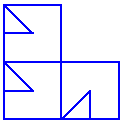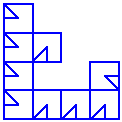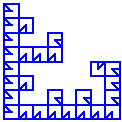Lab 11: Generalized Iterated Function Systems
Let's look at some fractals that are "relatives" of Sierpinski's Gasket. We introduce the concept of an oriented tile by marking a single square on a piece of graph paper with a triangle in the upper left hand corner (stage 0). Think of this as a piece of stained glass that you are going to place in a window. There are many different ways that you can orient the tile with different rotations or even by flipping the tile over.
Now imagine that you have an unlimited supply of tiles marked this way, and that you decide on an initial pattern by laying three of these tiles down as we have in stage 1 below.
In this example, the tiles in the upper- and lower-left positions are oriented the same way that the original tile, but the tile in the lower-right position has been rotated 270 degrees clockwise (or 90 degrees counter-clockwise, if you prefer).
Now continue in this fashion, at each stage replacing each tile with three tiles oriented in this fashion with respect to the tile that you are replacing. Look at the transition from stage 1 to stage 2 below.
Another way to look at the transition from one stage to the next is to take three copies of the previous stage and paste them together according to the rule of your original pattern above. In this case, lay copies in the upper- and lower-left positions with no change in orientation and lay a copy in the lower-right position that has been rotated 270 degrees clockwise (90 degrees counter-clockwise).
Visualize the transitions from stage 1 to stage 2, and from stage 2 to stage 3 (pictured below) in this way.
Your assignment is to follow this construction through to stage 5 and enjoy the pattern that develops.




